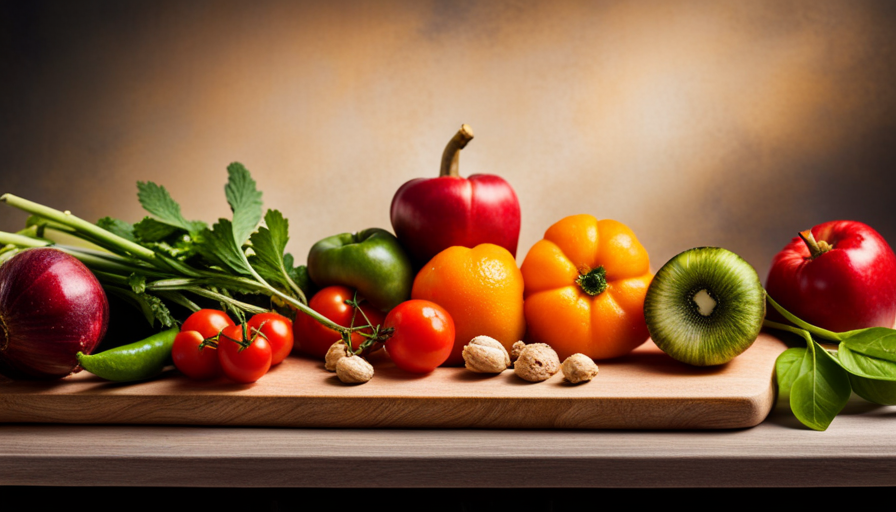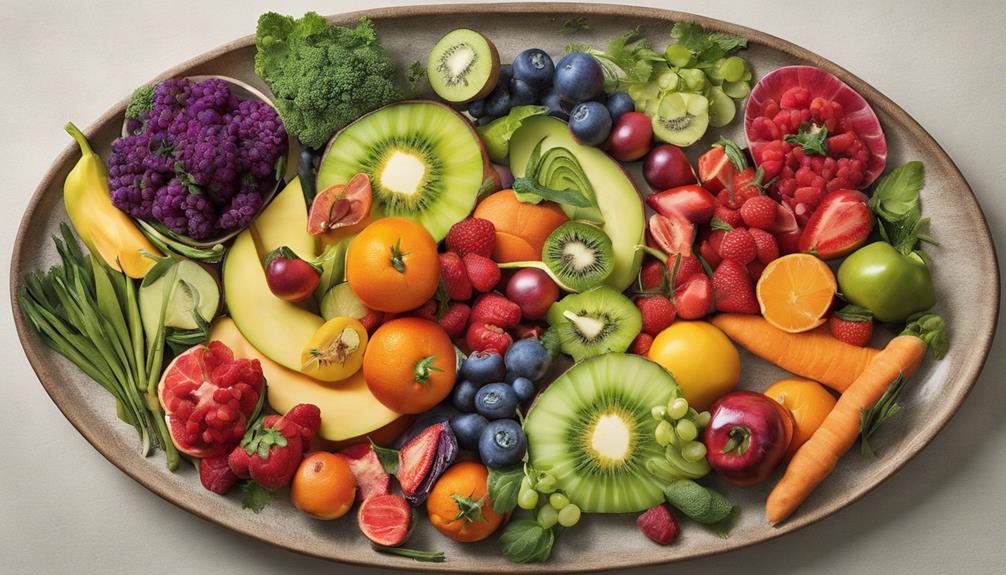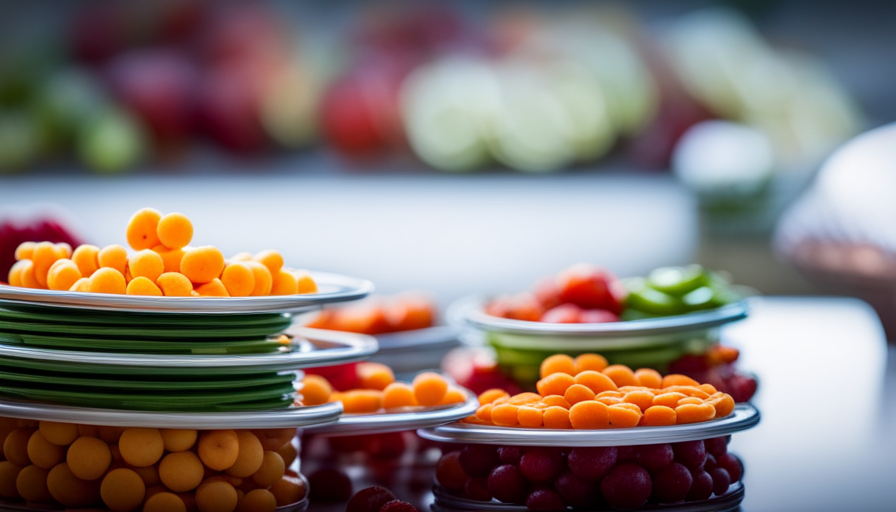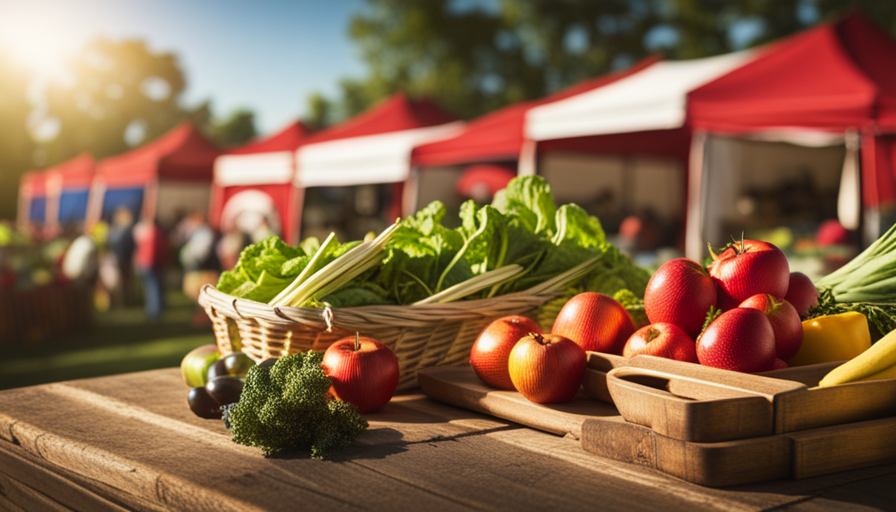Eating raw food means consuming it in its natural state, without cooking it. While it may seem unconventional, I can assure you that adopting this lifestyle has profoundly changed my connection with food.
Imagine vibrant fruits and vegetables, bursting with flavor and nutrients, untouched by the heat of a stove or oven. That’s what raw food is all about. It’s a way of eating that prioritizes the consumption of uncooked, unprocessed, and plant-based foods. And let me tell you, the benefits are astounding. From improved digestion and increased energy to glowing skin and weight loss, raw food has the power to revolutionize your health.
But it’s not all sunshine and rainbows. There are some potential drawbacks to consider, as well. In this article, I will delve into the definition of raw food, explore its nutritional benefits and potential drawbacks, discuss popular types of raw food diets, and provide tips for incorporating raw food into your diet.
Get ready to discover a whole new world of culinary possibilities.
Key Takeaways
- Raw food is uncooked, unprocessed, and plant-based.
- Raw food retains essential nutrients, enzymes, and antioxidants.
- Cooking food above a certain temperature can destroy enzymes and nutrients.
- Raw food is lower in calories and higher in fiber.
Definition of Raw Food
Do you ever wonder what exactly raw food means? Well, let me tell you, raw food refers to any type of food that hasn’t been cooked or heated above a certain temperature.
Raw food enthusiasts believe that consuming uncooked food provides numerous health benefits. It’s more than just a diet; it’s a lifestyle choice. Raw food is packed with essential nutrients, enzymes, and antioxidants that are often lost during the cooking process. These nutrients are vital for our overall well-being and can boost our immune system, improve digestion, and promote healthy weight management.
One of the main health benefits of eating raw food is that it helps maintain the natural enzymes present in the food. Enzymes play a crucial role in breaking down food and aiding digestion. Cooking food above a certain temperature can destroy these enzymes, making it harder for our bodies to digest and absorb nutrients.
Additionally, raw food is typically lower in calories and higher in fiber, which can contribute to weight loss and improved gut health.
Transitioning into the next section about the nutritional benefits of eating raw food, it’s important to note that raw food not only provides health benefits but also offers a wide variety of essential nutrients that are beneficial for our bodies.
Nutritional Benefits of Eating Raw Food
When it comes to the nutritional benefits of eating raw food, there are three key points to consider.
First, raw food retains its enzymes and nutrients, which can be lost through the cooking process. This means that by eating raw food, I’m maximizing my intake of essential vitamins and minerals.
Second, raw food is rich in fiber, which helps to improve digestion and promote a healthy gut.
Lastly, by eating raw food, I’m supporting improved digestion, as the natural enzymes present in raw food can aid in breaking down food more effectively.
Retention of Enzymes and Nutrients
To maximize the retention of enzymes and nutrients, you’ll want to ensure that your food remains in its raw state, untouched by heat or cooking. When you cook food, especially at high temperatures, you can destroy or denature enzymes and nutrients, reducing their availability and effectiveness.
Raw food, on the other hand, retains these vital components in their natural form, allowing your body to fully benefit from them. Enzymes are essential for digestion and nutrient absorption, while nutrients like vitamins, minerals, and antioxidants play a crucial role in supporting overall health and well-being.
By consuming raw food, you can preserve these valuable elements and reap their nutritional benefits. So, by including more raw foods in your diet, you can increase your fiber intake and experience the numerous advantages associated with this dietary choice.
Increased Fiber Intake
By incorporating more raw fruits and vegetables into your diet, you can increase your fiber intake, which can help promote healthy digestion. Did you know that just one cup of raspberries provides a whopping 8 grams of fiber? Increasing your fiber intake has numerous benefits, including increased energy, weight management, and improved digestion.
-
Increased energy: Fiber-rich foods help regulate blood sugar levels, preventing energy crashes and keeping you energized throughout the day.
-
Weight management: High-fiber foods are often low in calories and can help you feel fuller for longer, reducing the chances of overeating and aiding in weight management.
-
Improved digestion: Fiber adds bulk to your stool, making it easier to pass through your digestive system and preventing constipation.
With these benefits in mind, it’s clear that incorporating more raw fruits and vegetables into your diet can have a positive impact on your overall health and well-being, especially when it comes to improved digestion.
Improved Digestion
Incorporating more fruits and vegetables into your diet can significantly improve your digestion and overall well-being. Raw foods, in particular, have been shown to have a positive impact on digestion. When you consume raw fruits and vegetables, you’re getting a high amount of fiber, which aids in digestion by promoting regular bowel movements and preventing constipation.
Additionally, raw foods contain enzymes that help break down food and make it easier for your body to digest. This can result in less bloating, gas, and indigestion. Improved digestion is just one of the many health benefits of incorporating raw foods into your diet.
However, it’s important to note that there are potential drawbacks of a raw food diet, which will be discussed in the subsequent section.
Potential Drawbacks of a Raw Food Diet
Eating a raw food diet can have its drawbacks, such as feeling as if you’ve been transported back to the Stone Age. While there are potential health benefits to consuming raw foods, it is important to be aware of the potential health risks and nutritional deficiencies that can arise from this type of diet.
One of the main concerns with a raw food diet is the potential for foodborne illnesses. Raw foods, especially fruits and vegetables, can harbor bacteria such as E. coli and Salmonella, which can lead to food poisoning. This risk is further increased if the raw foods are not properly washed or prepared.
Additionally, a raw food diet may lead to nutritional deficiencies. Cooking food can break down certain compounds and make them more accessible for our bodies to absorb. For example, cooking can increase the availability of lycopene in tomatoes, which is a powerful antioxidant. By consuming only raw foods, you may miss out on these beneficial compounds.
To provide a visual representation of the drawbacks of a raw food diet, here is a table showcasing potential health risks and nutritional deficiencies:
| Potential Health Risks | Nutritional Deficiencies |
|---|---|
| Foodborne illnesses | Vitamin B12 |
| Iron | |
| Omega-3 fatty acids |
While a raw food diet can offer some health benefits, it is important to be aware of the potential drawbacks. The next section will explore popular types of raw food diets.
Popular Types of Raw Food Diets
Raw food diets come in various forms and can be tailored to individual preferences and dietary needs. Here are some popular types of raw food diets:
-
Raw Vegan Diet: This diet consists of uncooked plant-based foods, including fruits, vegetables, nuts, seeds, and grains. It’s rich in nutrients, antioxidants, and fiber, and it has been associated with numerous health benefits such as improved digestion, weight loss, and increased energy levels.
-
Raw Vegetarian Diet: Similar to the raw vegan diet, this diet includes raw plant-based foods, but it also allows for the inclusion of raw dairy products, eggs, and honey. It provides a wide range of nutrients and can be a great option for those who prefer to include some animal products in their diet.
-
Raw Paleo Diet: This diet focuses on consuming raw animal products, such as meat, fish, eggs, and organ meats, along with raw fruits, vegetables, nuts, and seeds. It aims to mimic the diet of our Paleolithic ancestors and is believed to provide optimal nutrition and promote better overall health.
-
Raw Juice Diet: This diet involves consuming only freshly squeezed juices from fruits and vegetables. It’s a popular detoxification method and is believed to improve digestion, boost the immune system, and increase nutrient absorption.
-
Raw Gourmet Diet: This diet emphasizes the preparation of raw foods in creative and flavorful ways. It involves using various techniques like dehydrating, fermenting, and sprouting to enhance the taste and texture of raw ingredients.
Incorporating raw food into your diet can be a wonderful way to improve your health and well-being. Now, let’s explore some tips for seamlessly integrating raw food into your daily meals.
Tips for Incorporating Raw Food into Your Diet
One simple way to embrace the vibrant and nourishing world of raw cuisine is by introducing flavorful and unprocessed ingredients into your daily meals. Transitioning to a raw food diet can be both exciting and challenging, so here are some tips to help you along the way.
| Tips for Transitioning | Raw Food Challenges |
|---|---|
| Gradually increase the amount of raw foods in your meals. | Cravings for cooked foods may arise. |
| Experiment with different raw food recipes to find what you enjoy. | Social situations can be difficult when dining out. |
| Incorporate more fruits and vegetables into your snacks. | It can be time-consuming to prepare raw meals. |
| Stay hydrated by drinking plenty of water and herbal teas. | It may take time for your body to adjust to the new diet. |
By following these tips, you can make the transition to a raw food diet smoother and more enjoyable. Remember that challenges may arise, such as cravings for cooked foods or difficulties in social situations. However, with patience and perseverance, you can overcome these obstacles and fully embrace the raw food lifestyle.
Next, we will explore various raw food preparation techniques to help you create delicious and nutritious meals without cooking.
Raw Food Preparation Techniques
When it comes to incorporating raw food into my diet, I’ve found that there are three key techniques that are essential: sprouting and soaking, juicing and blending, and dehydrating and fermenting.
Sprouting and soaking helps to activate the enzymes in the seeds and grains, making them easier to digest.
Juicing and blending allows me to easily consume a large amount of fruits and vegetables in one sitting, ensuring I get a wide variety of nutrients.
And dehydrating and fermenting are great for preserving foods and enhancing their flavors.
Sprouting and Soaking
Sprouting and soaking are common methods used to enhance the nutritional value of uncooked food. These techniques offer numerous benefits, including increased nutrient availability and improved digestion. Here are four key points to consider when incorporating sprouting and soaking into your raw food preparation:
-
Sprouting benefits: Sprouting seeds, grains, or legumes activates enzymes, making them easier to digest and increasing their nutrient content. Sprouts are also a great source of vitamins, minerals, and antioxidants.
-
Soaking techniques: Soaking nuts, seeds, or grains in water helps remove enzyme inhibitors and phytic acid, which can interfere with nutrient absorption. It also softens the food, making it easier to blend or chew.
-
Time and temperature: It’s important to follow proper soaking times and temperatures to ensure optimal results. Each type of food may require different soaking durations and water temperatures.
-
Rinse and drain: After soaking or sprouting, thoroughly rinse and drain the food to remove any leftover water and prevent bacterial growth.
By incorporating sprouting and soaking techniques into your raw food preparation, you can maximize the nutritional benefits of uncooked foods. Moving forward to the next section, let’s explore the benefits of juicing and blending.
Juicing and Blending
Let’s dive into the incredible benefits of juicing and blending for maximizing nutrition in your uncooked meals!
Juicing is a fantastic way to extract the essential nutrients from fruits and vegetables. By removing the fiber, juicing allows your body to quickly absorb vitamins, minerals, and antioxidants. It provides a concentrated dose of nutrients, giving your immune system a boost and promoting overall health. Plus, juicing can be a convenient way to consume a variety of fruits and vegetables in one go.
On the other hand, blending retains the fiber and can create delicious and nutritious smoothies. Blending recipes offer a great opportunity to experiment with different combinations, adding in nuts, seeds, and superfoods for added nutritional benefits.
Now, let’s move onto the next section about dehydrating and fermenting, where we explore even more exciting ways to prepare raw food.
Dehydrating and Fermenting
If you want to take your uncooked meals to the next level, you should definitely try dehydrating and fermenting for a burst of flavor and added health benefits.
Dehydrating techniques involve removing the moisture from fruits, vegetables, and even meat to concentrate their flavors and create crispy snacks. Fermentation, on the other hand, is a natural process where bacteria or yeast convert sugars into acids, gases, or alcohol, resulting in tangy and flavorful foods like sauerkraut, kimchi, or kombucha. These techniques not only enhance the taste of raw foods but also preserve their nutritional value.
By dehydrating, you can make delicious raw crackers, fruit leather, and jerky. Fermentation, on the other hand, adds probiotics and enzymes to your diet, aiding digestion and boosting your immune system. Incorporating these techniques into your raw food repertoire will open up a world of culinary possibilities and health benefits.
- Dehydrating intensifies flavors and creates crunchy textures.
- Fermented foods are rich in beneficial bacteria that support gut health.
- Dehydrated snacks are convenient for on-the-go munching.
- Fermentation can enhance the digestibility of certain foods.
- Dehydrating and fermenting allow for long-term food storage without losing nutrients.
Now, let’s delve into the next section about research and studies on raw food diets.
Research and Studies on Raw Food Diets
In my research on raw food diets, I’ve come across several studies discussing the health benefits and risks associated with this type of eating.
These studies have found that raw food diets can lead to weight loss, improved digestion, and increased energy levels. However, there are also risks involved, such as nutrient deficiencies and foodborne illnesses.
Additionally, long-term effects of following a raw food diet haven’t been extensively studied, so it’s important to approach this type of eating with caution and consult with a healthcare professional.
Health Benefits and Risks
Explore the vibrant world of raw food and discover how it can nourish your body, boost your immune system, and invigorate your senses. Raw food diets have gained popularity due to their potential health benefits. However, it is important to be aware of the potential risks involved. While raw food can provide essential nutrients, it may also pose health risks if not properly balanced. Raw diets often lack certain nutrients, such as vitamin B12, iron, and calcium, which can lead to deficiencies if not adequately supplemented. Additionally, consuming raw foods increases the risk of foodborne illnesses, as bacteria and parasites are not destroyed through cooking. To ensure nutritional adequacy, it is crucial to carefully balance raw food intake with other sources of nutrients. Transitioning into the next section, let’s explore the concept of nutritional adequacy and how it relates to raw food diets.
Nutritional Adequacy
Let’s dive into the concept of nutritional adequacy and discover how a well-balanced raw food diet can be as satisfying as a symphony to your taste buds. When following a raw food diet, it’s important to ensure that you’re meeting all your nutritional needs to avoid nutritional deficiencies and potential health risks.
Here are five key points to consider:
-
Variety is key: Incorporating a wide range of fruits, vegetables, nuts, and seeds can help provide a diverse array of essential nutrients.
-
Protein sources: Opt for plant-based protein sources like legumes, tofu, and tempeh to meet your protein requirements.
-
Healthy fats: Include sources of healthy fats like avocados, nuts, and seeds to support brain health and nutrient absorption.
-
Micronutrients: Pay attention to getting enough vitamins and minerals by consuming a variety of colorful fruits and vegetables.
-
Hydration: Stay hydrated by drinking plenty of water and including hydrating foods like cucumbers and watermelon.
By following these guidelines, you can ensure that your raw food diet is nutritionally adequate.
Transitioning into the subsequent section about ‘long-term effects’, it’s crucial to understand the potential impact of a raw food diet on our overall health.
Long-Term Effects
Discover the fascinating long-term effects of embracing a raw food lifestyle, and how it can transform your overall health and well-being. When you commit to a raw food diet, you are giving your body the nutrients it needs in their most natural form. The long-term health benefits are numerous. Firstly, by consuming raw foods, you are preserving the vital enzymes that aid in digestion and absorption of nutrients. This can lead to improved digestion and nutrient absorption over time. Secondly, raw foods are rich in antioxidants, which can help boost your immune system strength and protect against chronic diseases. Finally, the high fiber content in raw foods can promote a healthy digestive system and prevent constipation. With all these benefits, it’s no wonder that a raw food lifestyle is gaining popularity. Now, let’s explore some delicious raw food recipes and meal ideas.
Raw Food Recipes and Meal Ideas
Try out these delicious raw food recipes and get a taste of the vibrant colors and fresh flavors that come from uncooked ingredients. Raw food restaurants offer a variety of options that cater to different taste preferences.
From zucchini noodles with a creamy avocado sauce to a refreshing watermelon gazpacho, these recipes showcase the creativity and versatility of raw cuisine. Raw food desserts are a delightful way to satisfy your sweet tooth without compromising on health. Indulge in a decadent chocolate mousse made with avocado and cacao powder or a refreshing fruit tart with a nut-based crust.
Incorporating raw meals into your diet not only introduces you to new flavors, but it also provides numerous health benefits. Raw foods are rich in vitamins, minerals, and enzymes that are often destroyed during cooking. These nutrients support digestion, boost energy levels, and promote overall well-being. Additionally, the vibrant colors of raw fruits and vegetables indicate high levels of antioxidants, which protect against chronic diseases.
If you’re looking for more raw food inspiration, the raw food community and resources are a valuable asset. Join online forums or attend local meet-ups to connect with like-minded individuals who share a passion for raw cuisine. You can find recipe books, blogs, and YouTube channels dedicated to raw food preparation. Exploring these resources will provide you with a wealth of knowledge and endless possibilities for creating delicious and nutritious meals.
Raw Food Community and Resources
Contrary to popular belief, the raw food community offers a plethora of resources and support for those looking to explore uncooked cuisine. If you’re interested in trying raw food recipes and reaping the benefits of a raw food diet, here are three valuable resources to check out:
-
Online Communities: Joining online forums and social media groups dedicated to raw food can provide you with a wealth of information and support. Connect with like-minded individuals, ask questions, and share your own experiences and recipes.
-
Raw Food Recipe Books: There are countless raw food recipe books available that offer a wide range of delicious and nutritious meals. These books provide detailed instructions, ingredient lists, and often include beautiful photos to inspire your culinary creations.
-
Raw Food Workshops and Retreats: Attending workshops and retreats focused on raw food can be a transformative experience. These events often feature expert speakers, cooking demonstrations, and the opportunity to connect with other raw food enthusiasts. You’ll learn new techniques, gain knowledge about the benefits of a raw food diet, and come away with a renewed enthusiasm for the raw food lifestyle.
The raw food community offers a supportive network and a wealth of resources for those interested in exploring raw food recipes and embracing the benefits of a raw food diet. Personal reflections on the raw food lifestyle will be discussed in the next section.
Conclusion and Personal Reflections on the Raw Food Lifestyle
Immerse yourself in the raw food lifestyle and gain a newfound appreciation for the health benefits and culinary possibilities of uncooked cuisine. As I come to the conclusion of my journey in the raw food community, I can’t help but reflect on my personal experiences and the impact this lifestyle has had on my overall well-being.
One of the most significant changes I’ve noticed since embracing the raw food lifestyle is the improvement in my energy levels. Eating raw foods provides my body with a constant source of nutrients and enzymes, giving me sustained energy throughout the day. I no longer experience the mid-afternoon slumps or rely on caffeine to keep me going.
Moreover, the raw food lifestyle has also positively affected my digestion. The abundance of fiber in raw fruits and vegetables has improved my gut health and regularity, eliminating any bloating or discomfort I used to experience.
Not only has the raw food lifestyle improved my physical health, but it has also allowed me to explore a whole new world of flavors and textures. From vibrant salads to creamy nut-based desserts, there’s a wide variety of delicious and nutritious raw recipes to choose from.
My personal reflections on the raw food lifestyle have been overwhelmingly positive. It has transformed not only my health but also my relationship with food. I encourage anyone curious about this lifestyle to give it a try and experience the incredible benefits firsthand.
Frequently Asked Questions
Can you provide a step-by-step guide on how to prepare raw food dishes?
Preparing raw food dishes is like crafting a culinary masterpiece without the heat. To dive into the world of raw food recipes, start by gathering fresh, vibrant ingredients like fruits, vegetables, nuts, and seeds.
Then, employ raw food preparation techniques such as soaking, sprouting, and dehydrating to enhance flavors and textures. Experiment with creative combinations, seasonings, and dressings to create delightful and nutritious dishes that’ll leave your taste buds dancing with delight.
Are there any specific raw food diets that are recommended for weight loss?
There are specific raw food diets that are recommended for weight loss. These diets primarily consist of raw fruits, vegetables, nuts, and seeds. They are rich in nutrients, low in calories, and high in fiber, which can help promote weight loss.
Additionally, raw food recipes often focus on incorporating natural, whole foods that are minimally processed, further enhancing their weight loss benefits.
Overall, a raw food diet can be an effective way to support weight loss goals.
What are some common myths or misconceptions about raw food diets?
There are several common misconceptions about raw food diets. One is that they lack essential nutrients, but raw diets can provide a wide variety of vitamins, minerals, and antioxidants.
Another myth is that raw food diets are difficult to follow, but there are many delicious and easy-to-prepare raw recipes available.
Additionally, some people believe that raw food diets are only for vegans or vegetarians, but anyone can benefit from incorporating more raw foods into their diet.
Are there any potential health risks associated with consuming raw foods?
There are potential health risks associated with consuming raw foods, as they can be a source of foodborne illnesses such as salmonella or E. coli. However, raw foods also offer nutritional benefits, such as preserving enzymes and nutrients that can be lost during cooking.
It’s important to handle and prepare raw foods with care, by washing them thoroughly and avoiding cross-contamination, to minimize the risk of foodborne illnesses.
Where can I find online communities or resources for support and information about the raw food lifestyle?
Looking to connect with others and find resources for the raw food lifestyle? Well, you’re in luck! Online forums, social media groups, recipe websites, and raw food blogs are fantastic places to find support and information.
These virtual communities provide a platform for sharing tips, recipes, and experiences with like-minded individuals. Whether you’re a beginner or a seasoned raw food enthusiast, these online resources will surely help you on your journey to a healthier and more vibrant lifestyle.
What Are the Benefits of Eating Raw Foods?
Raw vegan cooking benefits extend beyond just healthy eating. By consuming raw foods, you can retain more nutrients, enzymes, and antioxidants, ultimately boosting your overall health. Additionally, it may aid in weight loss and improving digestion. Making the switch to raw vegan cooking can lead to a more vibrant and energized lifestyle.
Conclusion
After exploring the world of raw food, I’m left with a sense of awe and curiosity. The juxtaposition of the simplicity and complexity of raw food is truly fascinating.
On one hand, it offers a plethora of nutritional benefits and a vibrant, natural way of eating. On the other hand, there are potential drawbacks and challenges that come with adopting a raw food diet.
However, armed with knowledge and creativity, one can find ways to incorporate raw food into their diet and reap its many rewards. It’s a journey worth embarking on.










